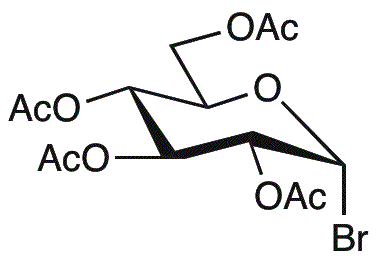Acetobromo-a-D-glucose is widely utilized in research focused on:
- Carbohydrate Chemistry: This compound serves as a key intermediate in the synthesis of various glycosides, which are essential for studying carbohydrate interactions and functions in biological systems.
- Pharmaceutical Development: It plays a role in the design of new drugs, particularly those targeting glycoproteins, which are important in cell signaling and immune responses.
- Biotechnology: Used in the production of modified sugars for use in biocatalysis, enhancing the efficiency of enzymatic reactions in industrial applications.
- Food Industry: It can be applied in the development of food additives and preservatives, improving shelf life and safety of products.
- Analytical Chemistry: This compound is utilized in various assays and experiments to analyze sugar structures and their reactivity, aiding in the advancement of analytical techniques.
General Information
Properties
Safety and Regulations
Applications
Acetobromo-a-D-glucose is widely utilized in research focused on:
- Carbohydrate Chemistry: This compound serves as a key intermediate in the synthesis of various glycosides, which are essential for studying carbohydrate interactions and functions in biological systems.
- Pharmaceutical Development: It plays a role in the design of new drugs, particularly those targeting glycoproteins, which are important in cell signaling and immune responses.
- Biotechnology: Used in the production of modified sugars for use in biocatalysis, enhancing the efficiency of enzymatic reactions in industrial applications.
- Food Industry: It can be applied in the development of food additives and preservatives, improving shelf life and safety of products.
- Analytical Chemistry: This compound is utilized in various assays and experiments to analyze sugar structures and their reactivity, aiding in the advancement of analytical techniques.
Documents
Safety Data Sheets (SDS)
The SDS provides comprehensive safety information on handling, storage, and disposal of the product.
Product Specification (PS)
The PS provides a comprehensive breakdown of the product’s properties, including chemical composition, physical state, purity, and storage requirements. It also details acceptable quality ranges and the product's intended applications.
Certificates of Analysis (COA)
Search for Certificates of Analysis (COA) by entering the products Lot Number. Lot and Batch Numbers can be found on a product’s label following the words ‘Lot’ or ‘Batch’.
Numéro de catalogue
Numéro de lot/série
Certificates Of Origin (COO)
This COO confirms the country where the product was manufactured, and also details the materials and components used in it and whether it is derived from natural, synthetic, or other specific sources. This certificate may be required for customs, trade, and regulatory compliance.
Numéro de catalogue
Numéro de lot/série
Safety Data Sheets (SDS)
The SDS provides comprehensive safety information on handling, storage, and disposal of the product.
DownloadProduct Specification (PS)
The PS provides a comprehensive breakdown of the product’s properties, including chemical composition, physical state, purity, and storage requirements. It also details acceptable quality ranges and the product's intended applications.
DownloadCertificates of Analysis (COA)
Search for Certificates of Analysis (COA) by entering the products Lot Number. Lot and Batch Numbers can be found on a product’s label following the words ‘Lot’ or ‘Batch’.
Numéro de catalogue
Numéro de lot/série
Certificates Of Origin (COO)
This COO confirms the country where the product was manufactured, and also details the materials and components used in it and whether it is derived from natural, synthetic, or other specific sources. This certificate may be required for customs, trade, and regulatory compliance.


